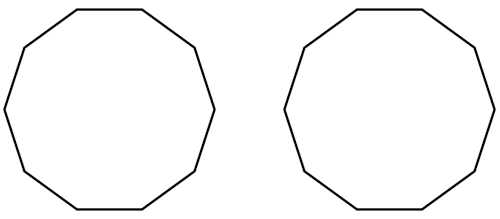
A puzzle by Russian mathematician Sergei Berlov:
Here are two decagons. Suppose that a positive integer is written at each of the 20 vertices such that the sum of the numbers around each decagon is 99. Prove that it’s possible to mark some number of successive vertices on each decagon so that the two sums of marked numbers are equal. (The marked segment on a given decagon may be a single vertex, but not all 10.)
|
SelectClick for Answer |
In place of each decagon, consider a circle whose circumference is 99 units long and divided into segments whose length corresponds to the vertex integers, in order. So if the first few vertices around one decagon bear the integers 14, 9, 30, then the corresponding segments of that circle will have those lengths.
Now superimpose the two circles and rotate one of them. If at any point two pairs of segment endpoints coincide simultaneously, then we have our solution — these endpoints identify two sets of successive vertices on the two decagons that produce the same sum.
What if we never get two simultaneous coincidences? Well, that’s impossible: During a full rotation, each endpoint on the first circle must encounter 10 endpoints on the other circle, so there are 100 coincidences altogether. These must occur over the course of 99 discrete opportunities (the lengths of the two circles’ circumferences), so some two coincidences must occur together.
From the January-February 1995 issue of Quantum.
|

